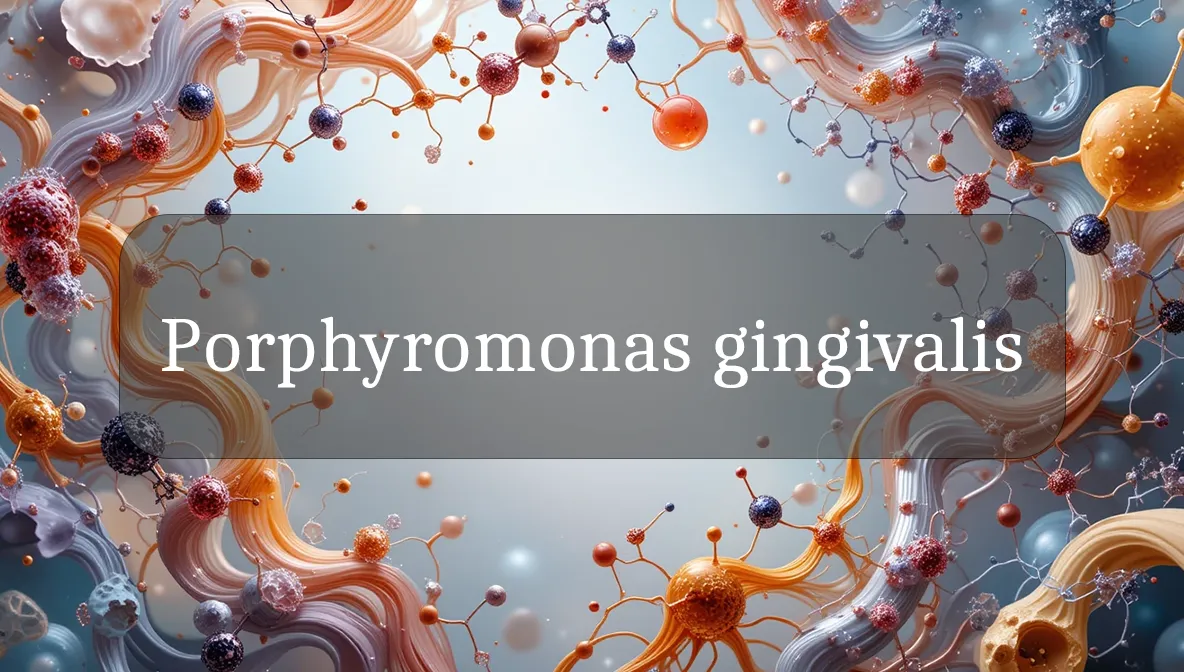Oral Bacterium with Big Health Impacts
Porphyromonas gingivalis is a bacterium primarily found in the mouth, often linked to gum disease but also implicated in broader health issues like heart disease and Alzheimer’s. This guide explains what P. gingivalis is, its role in your body, and practical steps to keep it in check for better oral and overall health, all in a clear, actionable way.
Identity and Function
Porphyromonas gingivalis is a Gram-negative, anaerobic (thrives without oxygen), rod-shaped bacterium in the Porphyromonas genus. It’s a key player in the oral microbiome, especially in dental plaque below the gumline. This bacterium produces enzymes and toxins, like gingipains, that break down proteins and trigger inflammation, allowing it to feed on gum tissue and evade the immune system. Think of P. gingivalis as a sneaky troublemaker that’s harmless in small amounts but can wreak havoc if it overgrows.
Health Benefits and Role
In a healthy mouth, P. gingivalis exists in low numbers and doesn’t cause harm:
- Microbial Balance: It’s part of the complex oral microbiome, contributing to microbial diversity and nutrient breakdown in tiny amounts.
- Immune Interaction: Low levels may help the immune system stay alert to microbial threats, maintaining balance.
However, its primary role is pathogenic, as overgrowth leads to serious health issues, which we’ll explore under dysfunction signs.
Natural and Supplemental Sources
P. gingivalis is naturally present in the mouth but isn’t consumed or supplemented:
- Natural Sources:
- Oral cavity: Thrives in subgingival plaque (below the gums), especially in areas with poor oral hygiene.
- Other sites: Rarely found in the gut or other body areas unless linked to infections or systemic spread.
- Supplemental Sources:
- P. gingivalis is not used in probiotics due to its harmful potential. Instead, beneficial bacteria like Lactobacillus or Bifidobacterium can help suppress it.
- Prebiotics: Foods like garlic, onions, bananas, or whole grains feed good bacteria, indirectly reducing P. gingivalis dominance.
- Probiotics: Oral probiotics with strains like Lactobacillus reuteri or Streptococcus salivarius may reduce P. gingivalis in plaque.
Maintaining good oral hygiene and a fiber-rich diet helps keep P. gingivalis under control.
Signs of Dysfunction
Overgrowth of P. gingivalis is linked to oral and systemic health problems:
- Oral Health Issues:
- Gingivitis: Red, swollen, or bleeding gums.
- Periodontitis: Advanced gum disease with deep pockets, bone loss, loose teeth, or bad breath.
- Systemic Health Issues:
- Heart disease: P. gingivalis can enter the bloodstream, contributing to artery plaque buildup and increasing heart attack risk.
- Alzheimer’s disease: Found in brain tissue of Alzheimer’s patients, where its toxins (gingipains) may trigger inflammation and amyloid plaque formation.
- Rheumatoid arthritis: Linked to joint inflammation due to immune system activation by its toxins.
- Colorectal cancer: Emerging research suggests a possible role in promoting gut inflammation and tumor growth.
- Diabetes: Worsens blood sugar control by increasing inflammation.
- General Symptoms:
- Persistent bad breath or a metallic taste.
- Systemic inflammation, fatigue, or fever if P. gingivalis spreads.
If you notice gum problems, persistent bad breath, or systemic symptoms, consult a dentist or healthcare provider. Tests like plaque sampling or blood markers can detect P. gingivalis involvement.
Supporting Optimal Function
The goal is to minimize P. gingivalis to prevent its harmful effects:
- Prioritize Oral Hygiene: Brush twice daily with fluoride toothpaste, floss daily, and use an antiseptic mouthwash (e.g., chlorhexidine or Listerine) to reduce P. gingivalis in plaque. Schedule dental cleanings every 6 months.
- Eat a Balanced Diet: Consume 25–35 grams of fiber daily from fruits, veggies, whole grains, and legumes to support beneficial bacteria that outcompete P. gingivalis. Limit sugary foods, which fuel harmful bacteria.
- Add Fermented Foods: Yogurt or kefir with live cultures (e.g., Lactobacillus) can promote a healthy oral and gut microbiome, reducing P. gingivalis growth.
- Quit Smoking: Smoking increases P. gingivalis levels and gum disease risk. Seek support to quit if needed.
- Exercise Regularly: Physical activity reduces inflammation and supports a healthy microbiome, indirectly controlling P. gingivalis.
- Manage Stress: Chronic stress weakens immunity, allowing P. gingivalis to thrive. Try mindfulness, deep breathing, or yoga.
- Medical Treatment: For periodontitis, dentists may use scaling, root planing, or antibiotics (e.g., doxycycline) to target P. gingivalis. Follow professional guidance.
These habits keep P. gingivalis in check, protecting your oral and systemic health.
Safety, Interactions, and Storage
P. gingivalis is a normal oral resident but dangerous when overgrown:
- Safety: Low levels are harmless, but poor oral hygiene, smoking, or a weakened immune system (e.g., from diabetes or HIV) can lead to overgrowth.
- Interactions:
- Antibiotics can reduce P. gingivalis but also disrupt beneficial bacteria. After treatment, use probiotics or fermented foods (taken 2–3 hours after antibiotics) to rebuild.
- High-sugar or low-fiber diets increase P. gingivalis in plaque, worsening gum disease.
- Storage:
- Probiotics or fermented foods used to balance P. gingivalis need proper storage. Refrigerate yogurt, kefir, or certain probiotic supplements to keep cultures alive; check labels for shelf-stable options.
- Precautions:
- If you’re immunocompromised, have diabetes, or are at risk for heart disease, be diligent about oral hygiene to prevent P. gingivalis-related complications.
- Seek immediate care for signs of severe gum disease or systemic infection (e.g., fever, swelling, or fatigue).
Fun Fact
Porphyromonas gingivalis is a master of disguise—it can “hide” from the immune system by altering its surface proteins, making it one of the sneakiest bacteria in your mouth! Good oral hygiene keeps this trickster in check.
Citations
- National Institutes of Health. (2024). Porphyromonas gingivalis and Periodontal Disease.
- Mayo Clinic. (2023). Gum Disease: Causes and Prevention.
- Cleveland Clinic. (2024). Oral Health and Systemic Disease Connections.
- World Health Organization. (2022). Oral Health and Chronic Disease Prevention.
- ScienceDirect. (2024). Porphyromonas gingivalis: Pathogenicity and Systemic Implications.

